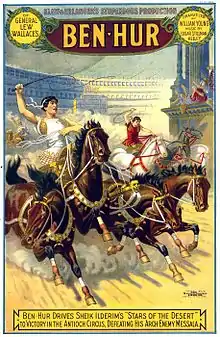
The toga play was a theatrical genre popular at the end of the nineteenth century and the start of the twentieth century. It combined plots from popular novels with inspiration from Victorian painters and composers, all set against a classically themed background.
Content
The toga play combined plots from popular novels with visual inspiration from contemporary Victorian painters such as Lawrence Alma-Tadema and Frederick Lord Leighton, and music from composers such as Charles Gounod, Giacomo Meyerbeer and Alexandre Luigini,[1] all set against a classically themed background.
The plays have been described by David Mayer as reflecting the cultural and social anxieties of their age, such as the rise of feminism, fears about mass migration, class conflict, and the future of the British Empire.[1]
Notable examples
Toga plays appeared both in mainstream theatre and in music hall entertainments from around the 1880s and were popular in Great Britain and the United States until the start of the twentieth century.[2] Among the notable examples were Claudian (1883), The Sign of the Cross (1895), and Ben-Hur (1899). They crossed over into silent film, for example, in Ben-Hur (1907) and The Barbarian Ingomar (1908).[1]
See also
References
- 1 2 3 Richards, Jeffrey, "Review: Playing out the Empire: Ben-Hur and other Toga Plays and Films, 1883-1908". D. Mayer (Ed.) New Theatre Quarterly, Volume 10, No. 40 (November 1994), p. 393.
- ↑ "Toga plays and tableaux vivants: Theatre and painting on London's late-Victorian and Edwardian popular stage", Rosemary Barrow, Theatre Journal, Vol. 62, No. 2 (May 2010), pp. 209–226.
Further reading
- Mayer, David. (Ed.) (1994) Playing out the Empire: Ben-Hur and other Toga Plays and Films, 1883-1908. Oxford: Clarendon Press. ISBN 0198119909
External links
![]() Media related to Toga plays at Wikimedia Commons
Media related to Toga plays at Wikimedia Commons